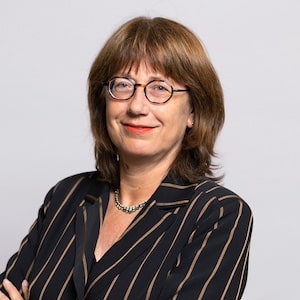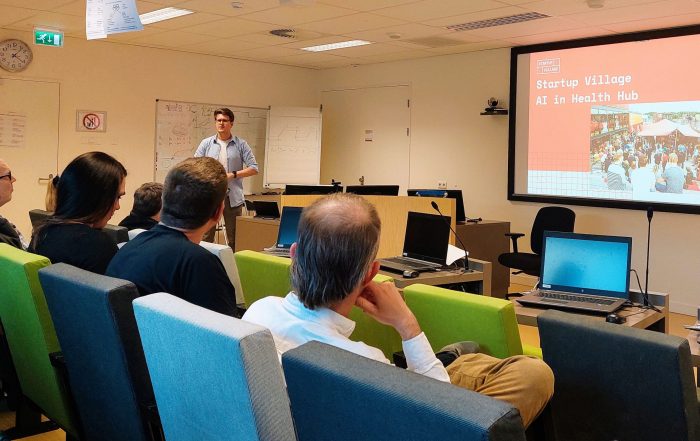‘Good data’ works for healthcare workers and number crunchers
Good data science needs good data. But your definition of what that is can depend on where you stand. Medical practitioners might need something else than data scientists do. The challenges of collecting data that works both for the professionals at the bedside and for the number crunchers behind their computers was highlighted at the latest edition of Medical Data + Pizza.
“Do data scientists think about exogenous data?” “A neurologist always wants every model.” Remarks made by the two speakers at the 23rd meetup in the Medical Data + Pizza series show that sometimes, there’s an understanding gap between data scientists and medical practitioners. The Medical Data + Pizza meetups, organised by Amsterdam Medical Data Science (AMDS) – of which the Amsterdam Economic Board is a founding partner – aim to help bridge that gap. Projects and new developments are presented, then everyone gets the chance to discuss them over pizza. The latest get-together took place on March 21st at Amsterdam UMC and threw up issues around statistical methods, exogenous vs endogenous data, discrete vs contiguous models and the urgent need for more investment in the resources needed to collect, maintain and share data. As always, there was plenty of food for thought. And also, food.
Predicting mortality risk – does Western bias come into play?
The first speaker was Daniella Brals, researcher at Amsterdam UMC and econometrician at the Amsterdam Institute of Global Health and Development. She presented her work on mortality risk prediction for children with acute illness in low-income and middle-income settings. The project was sparked when she connected with a UMC colleague who had worked in Malawi. He had noticed that his predictions about which child patients would survive and which would die were often wrong. This raised the question of whether there was a Western bias in the WHO’s clinical warning signs (CWS), which are used to predict mortality.
The CWS are presumed to predict poor outcomes in low and middle-income settings in children who are not severely acutely malnourished (SAM) and are evaluated only upon hospital admission. Brals and others launched a trial to assess firstly, to what extent the CWS can also be used to predict mortality in SAM children, and secondly, the value of structurally monitoring CWS every day during hospitalisation. The trial involved the secondary analysis of data from 843 hospitalised SAM children between six months and two years of age.
The data was analysed using a set of demographic and medical predictors as well as variables such as time to mortality and time to discharge. First explanatory models were made using backward selection to establish which of the potential predictors were most useful. Then the team built predictive models using the selected warning signs and other variables. Ultimately, the trial showed a better predictive performance when the CWS were monitored on a daily basis rather than simply at admission. And it showed that an almost tenfold increase in mortality was associated with a child displaying the top-five warning signs on any day during their hospitalisation. It was also established that the predictive model was most accurate for the first 48 hours after monitoring, declining steeply after that.
The aim of the trial was to establish a simple bedside tool for clinicians to assess the risk of mortality and respond accordingly. Brals is now involved in further studies with the Childhood Acute Illness and Nutrition Network. This global group of researchers focuses on optimising the care of highly vulnerable children in resource-limited settings. The mathematical models Brals is working on can also indicate which children have a low risk of dying – meaning scarce healthcare personnel and resources can be distributed most effectively to the patients who most need it.
How data can clarify treatment for ‘an uncertain disease’
The second speaker, Eva Strijbis, is working in a very different world. But for her, too, data is key. Strijbis is a neurologist at UMC’s MS Center Amsterdam and is bringing data to the battle against multiple sclerosis. The MS Center focuses on the early detection and targeted treatment of MS, which Strijbis describes as “an uncertain disease”. It almost always progresses in relapses and remissions. Each time a relapse occurs, the likelihood is that the patient is left with a higher degree of disability. There are treatments that can slow this cycle, but it’s not clearly understood why the effects of MS are mild in some patients and more severe in others. So a one-size-fits-all approach, while often taken, means that MS patients may be subjected to unnecessarily intense treatments. Strijbis believes data research can change this. A recently launched project named ‘The power of data’ hopes to enable the MS Center to offer tailored care to MS patients by 2030.
In a first step towards this goal, Strijbis has developed a database with a data platform and dashboard. The dashboard is linked to the electronic patient file and, with consent from the patient, gathers all the data from the past twenty years that is available to the MS Center: everything from diagnosis to check-ups, medication and scans. The dashboard is currently being used for relatively straightforward questions, but the next step is to use it for long-term research. Strijbis is enthusiastic about the possibility of creating detailed data-based patient profiles. Comparing these can help determine how the disease progresses and how patients with certain characteristics respond to certain treatments. And that means treatment can be tailored.
FAIR data and how to collect it
Data, says Strijbis, must be FAIR. Findable, Accessible, Interoperable and Reusable. And she says she faces quite some challenges on the road to achieving this. They include the ongoing legal and ethical issues around consent, privacy and data storage. Then there’s the problem of handling raw multimodal research data – Strijbis mentions that on just this one day, 50 scans have ‘gone missing’. They’re somewhere on the Center’s servers, but no one knows for sure where. Then there’s the issue of data generated by individual researchers, PhD students for instance, who join an institution and then leave on completion of their project, taking valuable knowledge with them.
But the biggest challenge is people, and it’s a two-part problem. First of all, practitioners need to be persuaded to observe the protocols needed to gather data accurately and consistently. The way to do this, says Strijbis, is to make it simple. Keeping records of one kind or another is an inescapable chore in healthcare. If the digital data-gathering system you devise is quicker to use than their current method, people will happily adopt it. The second problem is that there simply aren’t enough people. Once collected, data must be stored, maintained and shared as well as analysed by researchers. That requires long-term funding for skilled personnel and infrastructure. Strijbis’ must-haves include a neurologist, database manager, data scientist, data-unit personnel and a research data platform. Give her these, she says, and she’ll give you new weapons to keep MS at bay
Are you a researcher looking for inspiration or exposure? You can now sign up on the new AMDS website.
Sometimes medical professionals and data scientists do not sufficiently understand or even know each other at all. Our Right Data Right Now consortium wants to change that!
At the Medical Data + Pizza meetups, we discuss everything related to medical data science, including interesting projects, papers and the latest developments. This is where physicians and data scientists meet. It’s a great opportunity to learn, meet like-minded healthcare professionals, researchers and data scientists, get feedback on your own projects and have fun.
Read the reports about previous Medical Data + Pizza Meet-ups.
The Amsterdam Medical Data Science Group meetings are supported by The Right Data Right Now consortium, which includes Amsterdam UMC, OLVG, Vrije Universiteit, Pacmed, Amsterdam Economic Board and Smart Health Amsterdam.
30 March 2023
Read more about
Contact us
Want to keep up to date?
Get the best regional news and events (in Dutch) via the Board Update newsletter
Share this news
Want to keep informed?
Follow us daily on LinkedIn and sign up for the Board Update newsletter.
Read more
- What AI applications are we already deploying for healthcare and wellbeing? What ...
- Adyen is one of the great success stories of Amsterdam’s tech ...
- Together with enthusiastic partners in three coalitions, the Amsterdam Economic Board is ...




